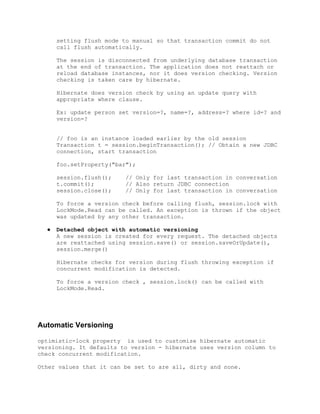Hibernate concurrency
- 1. Hibernate Concurrency Introduction Concurrency control in hibernate do not use any additional locking mechanism but relies on database connection concurrency controls. Unit of Work A unit of work of a web user can span multiple requests or database operations. Most commonly used pattern for such a web application is session per request model. A new session is created for every client request and closed once the response is generated. A database transaction is created once the session is opened and the transaction gets committed just before closing the session. So for every session there exists a corresponding transaction. For long conversations, a user does multiple interaction with database for single unit of work. Such series of database transactions can be atomic, if only the last transaction updates/inserts rows in the database and all others only execute select query. All transactions have to be begin,committed and rolled back explicitly. Hibernate automatically disables auto commit mode when fetching a new jdbc connection. The following are used in conjunction with above for concurrency control ● Automatic Versioning : HIbernate can automatically version database rows, so concurrent modification can be detected. ● Detached Objects: Is session per request model is used, then session is closed during user’s think time. The detached objects can are reattached with new session when a new request arrives. ● Long Session: With session per conversation approach, a session is not closed when a response is sent. The underlying jdbc connection is released. This approach does not require objects to be reattached. Session is flushed explicitly at the end of conversation and automatic versioning is used to check concurrent modification. Control flow in non managed environment Session s = factory.openSession(); Transaction tx = null;
- 2. try{ tx= s.beginTransaction(); //do work tx.commit(); //automatically flushes the session. }catch(RuntimeException e){ if(tx!=null)tx.rollback(); throw e; }finally { s.close(); } Optimistic Concurrency Control Optimistic concurrency control is the approach used in highly scalable and concurrent applications. Hibernate provides three approaches for writing application code that uses optimistic concurrency control. ● Application Version Checking: Application reloads the persistent state in a new session. The version column value before and after loading is compared. If the value is same, then no concurrent modification has taken place. The version column is mapped using <version> tag. The version value is automatically incremented by hibernate during flush if entity is dirty. Session s = factory.openSession(); Transaction t = s.beginTransaction(); int old_v = entity.getVersion(); s.load(entity, entity.getKey()); int new_v= entity.getVersion(); if(old_v!=new_v) throw new exception(); //do work ● Automatic version checking in extended session In session per conversation approach, same session is used for multiple requests of a conversation. For a new request of the conversation, database transaction is initiated. Automatic version checking is done at flush time and an exception is thrown if concurrent modification is detected.. Flush is called manually only for last transaction of the conversation. This is done by
- 3. setting flush mode to manual so that transaction commit do not call flush automatically. The session is disconnected from underlying database transaction at the end of transaction. The application does not reattach or reload database instances, nor it does version checking. Version checking is taken care by hibernate. Hibernate does version check by using an update query with appropriate where clause. Ex: update person set version=?, name=?, address=? where id=? and version=? // foo is an instance loaded earlier by the old session Transaction t = session.beginTransaction(); // Obtain a new JDBC connection, start transaction foo.setProperty("bar"); session.flush(); // Only for last transaction in conversation t.commit(); // Also return JDBC connection session.close(); // Only for last transaction in conversation To force a version check before calling flush, session.lock with LockMode.Read can be called. An exception is thrown if the object was updated by any other transaction. ● Detached object with automatic versioning A new session is created for every request. The detached objects are reattached using session.save() or session.saveOrUpdate(), session.merge() Hibernate checks for version during flush throwing exception if concurrent modification is detected. To force a version check , session.lock() can be called with LockMode.Read. Automatic Versioning optimistic-lock property is used to customize hibernate automatic versioning. It defaults to version - hibernate uses version column to check concurrent modification. Other values that it can be set to are all, dirty and none.
- 4. all: All fields are used for version check. the update statement has where clause that compares all previous and current values. dirty: If concurrent modifications can be permitted if changes do not overlap. Pessimistic Concurrency Control Pessimistic lock can be obtained by calling lock on the object. Hibernate uses the locking mechanism of underlying database. It does not lock objects in memory.Pessimistic locking is useful in scenarios where possibility of simultaneous update to same row is high. The explicit lock request is issued in one of the below ways session.lock(); session.load - with lockmode parameter Query.setLockMode() If lockmode is not supported by database, hibernate uses alternate mechanism instead of throwing exception to make applications portable. Lock Modes: LockMode.Write: This lock is automatically acquired on the object when hibernate updates or inserts a row. Lockmode.upgrade : is acquired by explicit select for update call. Lockmode.upgrage_nowait Lockmode.read is automatically acquired when hibernate reads a row under repeatable read or serializable isolation levels. It can be explicitly acquired also. LockMode.NONE: This is absence of locks. All objects switch to this lock mode at the end of transaction.



